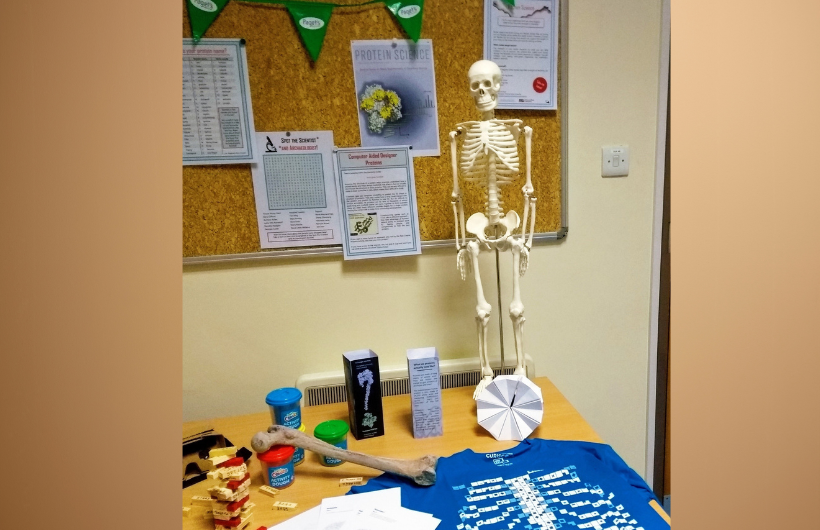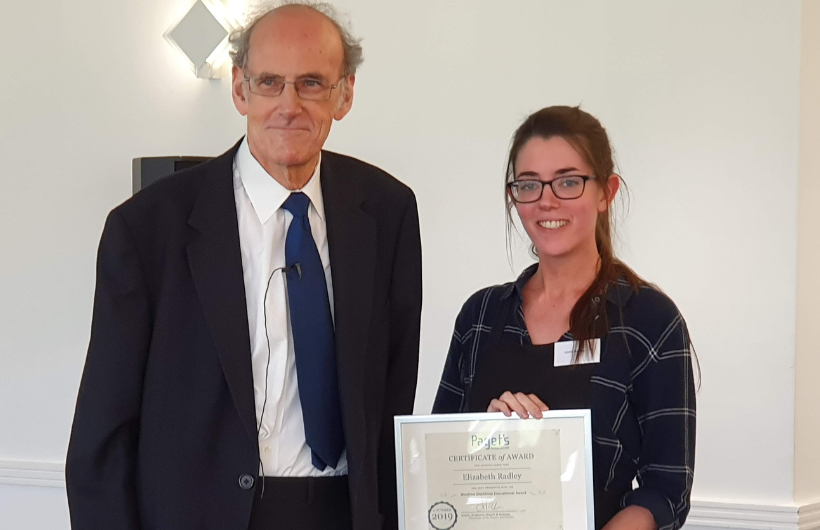Paget's disease: a public education programme
An educational award, in memory of the late Mrs Winifred Ditchfield, who had Paget’s disease, was presented to Elizabeth Radley at one of our Information Events, in Nottingham by Professor Grayson Ditchfield, who is Mrs Ditchfield’s son. Elizabeth, a PhD student at the University of Nottingham, used the Award to produce public education kits designed to raise awareness and understanding of Paget’s disease. [2022-2023]
You may have read in our magazine about the research at Norton Priory in Runcorn. Elizabeth produced a portable and reusable exhibit to showcase this research. With links to medicine, archaeology and history, it is envisaged that the exhibit will attract interest from a wide audience. It will include hands‑on activities and be accessible for school and university events, national science festivals, and for community use.
Elizabeth explains, "Representing one of the first ‘molecular’ diagnoses of an ancient bone disease, the research expanded our understanding of the natural history of Paget’s disease. This attracted a lot of media attention, with news articles published around the world and even a short section on BBC News!"
The Winifred Ditchfield Educational Award
"Clearly, the public was interested in the molecular mechanisms of Paget’s disease, both modern and ancient (as well they might be, it is very interesting!). To build on this and raise public awareness of Paget’s disease, I was awarded the Winifred Ditchfield Educational Award. I would like to express my sincere thanks to the Michael Davie Research Foundation who supported the Paget’s Association in creating this new educational award, and Professor Ditchfield who supported the award in memory of his mother, Winifred Ditchfield. Over several months I worked with researchers, public engagement experts and members of our ‘target audience’, to find out how we could engage the public with Paget’s disease research. As a result, I designed awareness kits which can be used at different events, such as Paget’s Information Days, science festivals, and community events. These portable and reusable kits use simple hands-on activities to explain complex ideas around the biochemistry, medicine, and archaeology of Paget’s research. In total, three kits were produced, each focusing on one of these subjects."
What Do the Kits Contain?
- Each kit contains 15 to 20 different activities around the specific topic. Given the diversity of the target audience, I kept the activities simple, with a flexible amount of medical, scientific and historical background information provided. These make the kits highly re-usable and sustainable; they need little adjustment to transition, from use with an audience of patients, to an audience of children visiting an archaeology museum, for example. I hope that a wide range of people will enjoy the activities. There is something for everyone and the audience chooses the level of medical biochemistry they explore.
- New to Paget’s and want to find out what it is all about? Or just want to play with virtual reality? Grab one of the Curiscope t-hirts and use a phone or tablet to take a virtual reality tour of your own skeleton. You can even sync it to your own heart rate! Compare this to the 3D printed pagetic bone and follow it up with the posters and information boards for an overview of the condition and to see how it affects your skeleton.
- Already know about Paget’s disease and want to learn how it actually works? Explore protein networks by trying to beat the Protein Jenga Tower, which mimics how proteins build up and interlock to form networks in healthy cells. But beware, one protein block out of place and the whole thing comes tumbling down! For more of a challenge include the wobbly protein blocks, such as Sequestosome 1 in Paget’s disease, which make it harder to build your protein tower.
- Feeling crafty? Make a movable skeleton hand, or get creative with some playdough to make a model of the Sequestosome 1 protein, which is linked to Paget’s.
- Of course, there is the obligatory activity with pipe cleaners – you can use them to get an in-depth look at how scientists are understanding protein shape and how it relates to disease.
- Inspired by all the (really cool) science? Play the Spot the Scientist wordsearch or the Find Your Scientist Name game and learn about some key scientists and archaeologists.
- There are also jigsaws to identify proteins from ancient skeletons, pin the tail on the donkey inspired games (okay, pin the biochemistry on the archaeology), take-home activities to turn your own kitchen into a science lab, colouring books, origami proteins, bendy skeletons, and computer-aided designer proteins."
Each kit comes complete with instructions, an information display board and everything you need to get stuck in with the cutting edge biochemical science that researchers, like those at the University of Nottingham, are conducting, to understand what Paget’s disease is, how it has developed throughout history, how it affects individuals and how we can help manage it. This project was perfectly timed to coincide with the media attention surrounding the research into ancient Paget’s disease, establishing a legacy of long-term public awareness of Paget’s disease and the Paget’s Association. Exhibition of the kits at Paget’s Information Days, community events, institution open days and science festivals will raise awareness of Paget’s, the Paget’s Association and the vital research it funds. It could also encourage uptake of science, technology, engineering and maths subjects into Higher Education and will hopefully encourage further cross-disciplinary collaborations between biochemists, archaeologists and medical charities.
Long term use
Elizabeth said, "Making these kits available to a wide variety of events will help increase visibility and awareness of Paget’s in the general public. This will raise understanding with those who have never heard of the condition. I hope increasing awareness of Paget’s disease in this way can have longer term effects, such as helping patients understand and feel comfortable with the management of their condition. Medical diagnoses and treatment plans can be daunting and feel detached from the patient’s day-to-day life and experience, and I hope that by trying some of these interactive activities, people can understand the processes behind their symptoms and can connect with their treatment. Overall, I hope that using these kits will be just as fun and educational for the public as designing them was for me. The Winifred Ditchfield Educational was a great opportunity and I look forward to seeing the kits in use!"
These portable and reusable kits use simple hands-on activities to explain complex ideas around the biochemistry, medicine, and archaeology of Paget’s research. In total, three kits were produced, each focusing on one of these subjects
Elizabeth Radley

